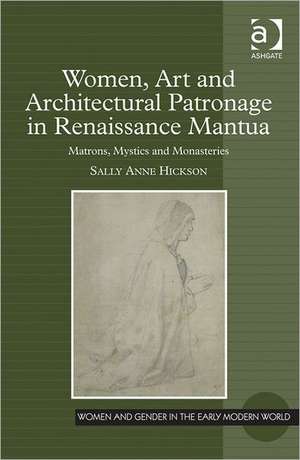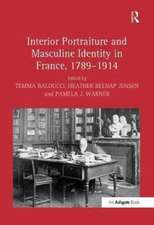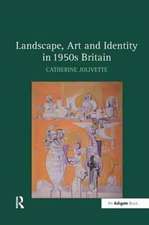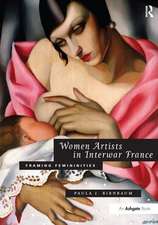Women, Art and Architectural Patronage in Renaissance Mantua: Matrons, Mystics and Monasteries: Women and Gender in the Early Modern World
Autor Sally Anne Hicksonen Limba Engleză Hardback – 28 mar 2012
| Toate formatele și edițiile | Preț | Express |
|---|---|---|
| Paperback (1) | 322.31 lei 6-8 săpt. | |
| Taylor & Francis – 17 noi 2016 | 322.31 lei 6-8 săpt. | |
| Hardback (1) | 817.62 lei 6-8 săpt. | |
| Taylor & Francis – 28 mar 2012 | 817.62 lei 6-8 săpt. |
Din seria Women and Gender in the Early Modern World
- 19%
 Preț: 390.79 lei
Preț: 390.79 lei - 26%
 Preț: 759.80 lei
Preț: 759.80 lei - 26%
 Preț: 815.19 lei
Preț: 815.19 lei - 26%
 Preț: 760.60 lei
Preț: 760.60 lei - 26%
 Preț: 815.19 lei
Preț: 815.19 lei - 26%
 Preț: 762.07 lei
Preț: 762.07 lei - 26%
 Preț: 816.41 lei
Preț: 816.41 lei - 26%
 Preț: 759.80 lei
Preț: 759.80 lei - 26%
 Preț: 765.48 lei
Preț: 765.48 lei - 26%
 Preț: 844.87 lei
Preț: 844.87 lei - 26%
 Preț: 816.41 lei
Preț: 816.41 lei - 26%
 Preț: 759.80 lei
Preț: 759.80 lei - 26%
 Preț: 494.22 lei
Preț: 494.22 lei - 26%
 Preț: 759.80 lei
Preț: 759.80 lei - 17%
 Preț: 245.97 lei
Preț: 245.97 lei - 26%
 Preț: 816.18 lei
Preț: 816.18 lei - 26%
 Preț: 821.26 lei
Preț: 821.26 lei - 26%
 Preț: 814.78 lei
Preț: 814.78 lei - 26%
 Preț: 763.86 lei
Preț: 763.86 lei - 26%
 Preț: 759.80 lei
Preț: 759.80 lei - 26%
 Preț: 814.78 lei
Preț: 814.78 lei - 26%
 Preț: 815.19 lei
Preț: 815.19 lei - 26%
 Preț: 762.64 lei
Preț: 762.64 lei - 26%
 Preț: 816.81 lei
Preț: 816.81 lei - 26%
 Preț: 870.52 lei
Preț: 870.52 lei - 26%
 Preț: 759.80 lei
Preț: 759.80 lei - 17%
 Preț: 245.97 lei
Preț: 245.97 lei - 17%
 Preț: 233.54 lei
Preț: 233.54 lei - 26%
 Preț: 818.83 lei
Preț: 818.83 lei - 26%
 Preț: 762.43 lei
Preț: 762.43 lei - 26%
 Preț: 818.02 lei
Preț: 818.02 lei - 26%
 Preț: 730.51 lei
Preț: 730.51 lei - 26%
 Preț: 759.80 lei
Preț: 759.80 lei - 26%
 Preț: 818.83 lei
Preț: 818.83 lei - 26%
 Preț: 818.44 lei
Preț: 818.44 lei - 26%
 Preț: 873.50 lei
Preț: 873.50 lei - 26%
 Preț: 820.32 lei
Preț: 820.32 lei - 26%
 Preț: 818.35 lei
Preț: 818.35 lei - 26%
 Preț: 842.04 lei
Preț: 842.04 lei - 26%
 Preț: 732.14 lei
Preț: 732.14 lei - 26%
 Preț: 822.09 lei
Preț: 822.09 lei - 26%
 Preț: 818.44 lei
Preț: 818.44 lei - 26%
 Preț: 755.59 lei
Preț: 755.59 lei - 26%
 Preț: 815.14 lei
Preț: 815.14 lei - 26%
 Preț: 823.01 lei
Preț: 823.01 lei - 26%
 Preț: 849.74 lei
Preț: 849.74 lei - 26%
 Preț: 818.02 lei
Preț: 818.02 lei - 26%
 Preț: 706.10 lei
Preț: 706.10 lei - 26%
 Preț: 821.38 lei
Preț: 821.38 lei
Preț: 817.62 lei
Preț vechi: 1104.18 lei
-26% Nou
Puncte Express: 1226
Preț estimativ în valută:
156.49€ • 163.10$ • 130.27£
156.49€ • 163.10$ • 130.27£
Carte tipărită la comandă
Livrare economică 06-20 ianuarie 25
Preluare comenzi: 021 569.72.76
Specificații
ISBN-13: 9781409427520
ISBN-10: 1409427528
Pagini: 204
Dimensiuni: 156 x 234 x 13 mm
Greutate: 0.59 kg
Ediția:1
Editura: Taylor & Francis
Colecția Routledge
Seria Women and Gender in the Early Modern World
Locul publicării:Oxford, United Kingdom
ISBN-10: 1409427528
Pagini: 204
Dimensiuni: 156 x 234 x 13 mm
Greutate: 0.59 kg
Ediția:1
Editura: Taylor & Francis
Colecția Routledge
Seria Women and Gender in the Early Modern World
Locul publicării:Oxford, United Kingdom
Cuprins
Contents: Introduction: saints and the city; Popular devotion: Isabella d'Este, the Beata Osanna Andreasi and depictions of female sanctity in Mantua; Friendship and devotion: Margherita Cantelma and Isabella d'Este; Partners in piety: Margherita Cantelma, Isabella d'Este and the monastery of Santa Maria della Presentatzione in Tempio in Mantua; Daughters of devotion: Suor Ippolita Gonzaga and Suor Paola Gonzaga in Mantua; Gonzaga family piety and sisterly affection: Margherita Paleologa, first Duchess of Mantua; Appendices; Bibliography; Index.
Notă biografică
Sally Hickson is Associate Professor of Art History at the University of Guelph (Canada), where she teaches Italian Renaissance and Baroque art and architecture.
Recenzii
'Hickson widens the scope of Isabella d'Este's art patronage and explores its relationship to other court women's commissioning of art by calling attention to the marchesa's virtually overlooked spirituality and monastic projects and demonstrating their effect on her daughters and daughter-in-law... The interaction between the lay and religious Gonzaga women that the author proposes offers important insights into women's artistic practices and the female networks that linked them during the first half of the sixteenth century. All in all, the book provides solid evidence that Isabella's artistic endeavors were richer and more influential than assumed in the existing scholarship.' Jeryldene Wood, University of Illinois, Urbana-Champaign, USA
'Sally Hickson’s monograph takes as a point of departure Isabella d’Este in her widowhood, by 1518 a patron of devout imagery. The book defines networks between her female relatives and friends to present a complex and sympathetic study of the intertwined patronage of Mantuan women in mourning over several generations.' Renaissance Quarterly
'As a whole, the volume’s five chapters present a refreshingly original picture of how partnerships between Mantua’s secular women and nuns defined spiritual values while contributing to the city’s built and visual environment during the early years of the Catholic Reformation.' CAA Reviews
'... this book offers scholars a much-needed look at Isabella d’Este’s religious patronage and provides an important introduction to several women whose activities nuance our understanding of early modern spirituality. Hickson’s initial foray into the complex networks of female piety that coalesced within the ruling family of sixteenth-century Mantua should prompt others to explore the topic further.' American Historical Review
'... a welcome break away from traditionally secular models of Gonzaga court patronage by focusing on Isabella d'Este's under-explored activities as a patron of religious projects. In doing so, the well-known Isabella becomes a vehicle for studying a network of previously hidden secular women and nuns, who emerge for the first time as a defining feature of Mantua's spiritual and built landscape during the earliest period of the Catholic Reformation.' European History Quarterly
'Hickson's archival work is to be applauded, and she successfully examines several fascinating examples of religious art patronage. These case studies offer further important examples of ties forged between convents and the outside world, and of the cultural as well as religious significance of the 'living saints' of Renaissance Italy.' Ecclesiastical History
'Sally Hickson’s monograph takes as a point of departure Isabella d’Este in her widowhood, by 1518 a patron of devout imagery. The book defines networks between her female relatives and friends to present a complex and sympathetic study of the intertwined patronage of Mantuan women in mourning over several generations.' Renaissance Quarterly
'As a whole, the volume’s five chapters present a refreshingly original picture of how partnerships between Mantua’s secular women and nuns defined spiritual values while contributing to the city’s built and visual environment during the early years of the Catholic Reformation.' CAA Reviews
'... this book offers scholars a much-needed look at Isabella d’Este’s religious patronage and provides an important introduction to several women whose activities nuance our understanding of early modern spirituality. Hickson’s initial foray into the complex networks of female piety that coalesced within the ruling family of sixteenth-century Mantua should prompt others to explore the topic further.' American Historical Review
'... a welcome break away from traditionally secular models of Gonzaga court patronage by focusing on Isabella d'Este's under-explored activities as a patron of religious projects. In doing so, the well-known Isabella becomes a vehicle for studying a network of previously hidden secular women and nuns, who emerge for the first time as a defining feature of Mantua's spiritual and built landscape during the earliest period of the Catholic Reformation.' European History Quarterly
'Hickson's archival work is to be applauded, and she successfully examines several fascinating examples of religious art patronage. These case studies offer further important examples of ties forged between convents and the outside world, and of the cultural as well as religious significance of the 'living saints' of Renaissance Italy.' Ecclesiastical History
Descriere
Combining primary archival research, contextual analysis of the climate of female mysticism, and a re-examination of a number of visual objects, this study sheds new light on the social, cultural and religious impact of the cult of female mystics of Mantua in the late fifteenth and early sixteenth centuries. It offers new insight into a complex world of sacred patronage, devotional practices and religious roles for women inside and outside the convent walls.














